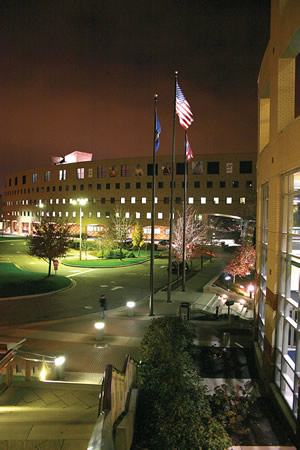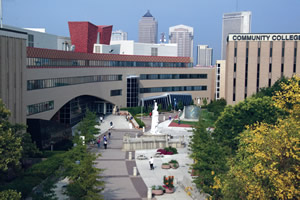Access Control Final Exam
- By Michael Fickes
- 09/01/16

PHOTOS COURTESY OF COLUMBUS STATE COMMUNITY COLLEGE
Shots rang out at the
University of California, Los
Angeles (UCLA) on Wednesday,
June 1, killing William S. Klug, a
professor of mechanical and aerospace
engineering. The shooting occurred in
an office in the engineering building.
Officials put the campus on lockdown as
police officers searched the campus for
the shooter (who, it was discovered, had
committed suicide in Klug’s office).
Forty thousand students attend UCLA,
and locking down the huge center-city
campus is no easy task. News reports said
that some doors had no locks and opened
outwardly. Students piled barricades in
front of those doors. Students secured
other doors that did not have locks with
belts and cords.
After the incident, Scott Waugh, UCLA’s
executive vice chancellor and provost, said
that the campus emergency notification
went well but that the university would undertake
a review of campus doors and locking
capabilities to make sure that all doors
could from now on be locked efficiently
with actual locking mechanisms.
What must officials consider when
evaluating access control on a college or
university campus? What are the issues
and the priorities?
First comes the issue of deciding
who can go where and when. When may
faculty, students and administrators get
into this building? What about that building?
Will you control access to all kinds
of buildings — classroom buildings,
residence halls, libraries and so on — or
just certain buildings?
Next, school officials must figure out
how to manage visitors. Given that most
campuses are open to the public, security
must consider patrols to ensure that
visitors roaming the grounds are only just
roaming.
Then, too, there is an issue about admitting
visitors to campus buildings. Some
buildings — the library, perhaps — may
remain open to the public during certain
hours, depending on the security profile of
the campus.
In the case of locked buildings, officials
must set policies that control how security
will manage visitors as they come and go.

PHOTOS COURTESY OF COLUMBUS STATE COMMUNITY COLLEGE
PARTNERS IN SAFETY. Urban institutions, such as Columbus
State Community College in downtown Columbus,
OH, are having success in increasing campus safety by
partnering with their surrounding communities. These
town-gown relationships not only improve safety but also
increase development in the area.
Security Around Columbus
State Community College
Like most colleges and universities,
Columbus State Community College
(CSCC) maintains an open campus in downtown Columbus, OH. Unlike many
urban schools, the CSCC campus neighborhood
is considered one of the safest in
Columbus.
“The security profile of the neighborhood
is enhanced by the college’s 10-year
collaboration with the Discovery Special
Improvement District (SID),” says John
Nestor, Ph.D., director of asset management
(and former director of public safety)
at CSCC, a non-residential state community
college with its largest campus located in
downtown Columbus. “In the SID, property
owners voluntarily pay an additional
property tax in exchange for additional
police security patrols and social intervention
services.
“Furthermore, the college has committed
to assuming a neighborhood leadership
role in urban renewal partnership with the
City of Columbus.”
The urban renewal partnership
between CSCC and Columbus appears
to be working. Nestor notes that it has
spawned retail and residential development
in the area.
Who Can Go Where on Campus?
CSCC, then, is a relatively safe campus
at the start. Nevertheless, school officials
have developed a comprehensive access
control program to ensure an even greater
degree of safety.
Here’s how Columbus State Community College summarizes its policies regarding
access control: “Priority for further card
access control at our school was based on
areas of high value due to equipment content,
hazardous lab materials, protected
records or high levels of public interactions,”
says Nestor.
Nestor also notes that the college’s own
24-hour-per-day campus police department
contributes to the overall access
control program. The department’s facility
houses state-of-the-art integrated communication,
security and fire monitoring
systems supported by the institution’s
expert IT department.
CSCC’s access control program covers
a list of needs that required a significant
investment by the college. The administration
bought and installed security system
upgrades that enabled the integration of
the various security technologies used on
campus, says Nestor. The upgrades included
expanded card access control, public space
cameras and central and redundant realtime
monitoring of fire and security systems.
In addition, real-time monitoring technology
keeps an eye on the fire and security
systems, including the emergency message
and public address systems, a crime tip
text line and a technology-based virtual
security escort smartphone app.
According to Nestor, the goal is to
provide lines of communication with
students and employees that are so open
and so quick to communicate that CSCC
can deliver support before anyone feels the
need to send an emergency text.

PHOTOS COURTESY OF COLUMBUS STATE COMMUNITY COLLEGE
IF YOU SEE SOMETHING, SAY SOMETHING. Successful access
control programs encourage students and staff to be
continuously aware, and report any suspicious or out-of-place
persons or activities. Smartphone apps; anonymous,
text-enabled tip lines; and public-space cameras improve
an institution’s ability to protect its population by involving
them in monitoring their surroundings.
Day-To-Day and Overall
Program Management
“We don’t grant access freely,” says
Nestor. “Access is granted on an as-needed
basis as determined by department administrators
and their program work. The administrators
then request that the facilities
management security system coordinators
program the permissions to access cards.
In this way, personnel access is managed
and revised day-to-day.”
Nestor describes the overall campus
security program as successful thanks to
its multilayer and integrated approach to
security systems, community policing and
behavior assessment teams.
How can a campus security department
create a multilayered and integrated
approach to security systems? “It requires
systemic and laborious thinking,” he
says. “Take the time up front to identify
potential linkages. Otherwise, you may
end up with the right solution but not the
best solution. Enhancing and integrating
security access requires private and public
sector managers to have one foot in the
present and another in the future.
“They must focus on prevention and
provide helpful security services to students
and employees — and also be ready
to respond to a critical incident.
“It’s a daunting task, I know. But as a
parent of a college student, the college’s
security footprint was one of the most
important criteria we considered when
sending my young adult to college.”
Indeed, studies suggest that the vast
majority of parents take an interest in
security when considering colleges and
universities. In a recent survey of 985
parents of students considering college
and attending college, noodle.com, a
website the researches issues that can
help parents and students make learning
decisions, found that 75 percent rated
“safe environment” as highly important
to their decisions. In fact, security ranked
second in importance on a list of 19 factors
considered highly important by the
respondents.

PHOTOS COURTESY OF COLUMBUS STATE COMMUNITY COLLEGE
The Safest
In fact, CCSC recently received recognition
as the safest campus in the nation
from bestcolleges.com, a website that
researches various college and university
issues and develops rankings designed to
help students and parents choose a school.
“But as all security professionals
recognize, anything can happen anywhere,
anytime,” Nestor says. “Colleges mirror
the societies they serve. In that regard,
campus police actively engage the campus
in training and are adequately equipped to
respond to critical incidents in partnership
with other police and fire jurisdictions.”
Never Finished
What’s the next security step for Columbus
State Community College? Nestor
says the college creates a new security plan
every five years and that planning is beginning
for the next five years.
What security issues will characterize
that period? “With the continued development
of smartphones and apps, there is the
potential for college ID cards to become
obsolete and be replaced by apps, which
can also be used for access,” Nestor says.
“However, we prefer to be on the
cutting edge, not the bleeding edge, of
technology,” he continues. “Cybersecurity
of wireless access devices such as smartphone
apps or proximity readers may be
the future, but the risks of wireless codes
being intercepted by hackers must be addressed
first.”
LICENSE PLATE RECOGNITION
Nestor also indicates that some
colleges are exploring and deploying
license plate recognition (LPR) as a security
application.
“LPR will eventually render parking
permit stickers obsolete, eliminating the
overhead costs of sales and distribution of
car stickers,” says Nestor.
When that happens, campus security
will begin using license plate numbers,
he continues. Parking control vehicles or
campus police vehicles can carry license
plate readers that will alert on vehicles
whose owners have not registered or paid
the campus parking system fee.
Finally, an LPR system can alert campus
police to vehicles linked to crimes. Those
vehicles, of course, may be on campus in
support of some kind of criminal activity.
This article originally appeared in the College Planning & Management September 2016 issue of Spaces4Learning.